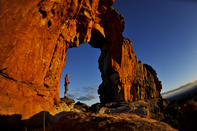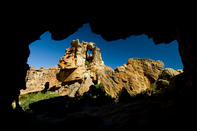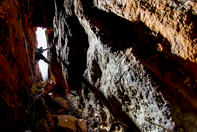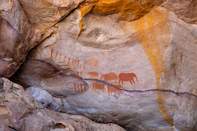Carved into Weird Forms
The Cederberg is perhaps best known for its fantastical rock formations. These have been caused by eons of rain and snow eating into the quartzitic sandstone boulders and cliffs, picking and carving them into weird forms: winged goddesses, massed chess pieces, many-headed monsters — the imagination soars.

It is not so much mechanical erosion at work here, for water, no matter how hard it falls, cannot erode rock. It is the chemical action of rainwater, a weak acid solution, that erodes the rock surfaces.
The Tafelberg Spaceship

The Cederberg Mountains in the Western Cape are famous for their many remarkable rock formations — the Maltese Cross, Wolfberg Arch, Wolfberg Cracks and Stadsaal among them. Much less well known is the Tafelberg Spaceship, because a trip to the top of the most impressive feature of the range is more of an expedition than a simple look-see.
It's a good day-long walk to the base of the Tafelberg, then you have to do a hard slog up the scree slope and go past the Spout. Finally, a difficult squirm up a water-polished chimney brings you to the alien landing zone. It was seen first by mountaineering surveyor Gother Mann and his helper, a local Cederberger named Viljoen, in 1896. Mann had to haul him up the 8 m chimney with a rope made from shoelaces, a belt and a handkerchief. A solution worthy of a MacGyver show, indeed.
Wolfberg Cracks

Cederberg: Best Loved Mountain Region

For decades during the golden years of mountaineering the search was on for the highest peak in the Western Cape. Over the years there were many contenders - Groot Winterhoek Peak and Sneeuberg in the Cederberg were strong early challengers — but it turned to be Matroosberg, 2 249 m, in the Hex River Mountains.
San Rock Art

The Cederberg, however, has remained the best-loved of the mountain region, partly for the fantastical rock formations, the great rock, some of the best in the world, and the San rock art, which rivals the Drakensberg, and partly for the lost-world settlements like Eselbank and Dwarsrivier and the rivers, rock pools and glorious cedar trees that used to grow in forested profusion but they have just about all been cut down for doors, chairs, roof cupboards and telephone poles.
Deep erosion of the Table Mountain Sandstone formation has left a number of parallel ridges, with towering peaks and incised valleys, while a prominent shale band forms a level platform — known as Die Frap "The Step" — around most of the major peaks. This shale 'running board' gives easy hiking access to much of the range.
The hiking secret of the range is this rock horizon of shale that acts as a mid-altitude plane connected by stone hiking paths, laid by the early woodcutters so their donkeys and mules could carry out the timber, with tiny woodcutter's huts strategically placed.
By David Bristow The Cape Rock Route is a self-drive route of wild rocks and towering mountain passes - arguably one the most dramatic and scenic routes in t...
The Cape Rock Route is a self-drive route of wild rocks and towering mountain passes - arguably one the most dramatic and scenic routes in t...